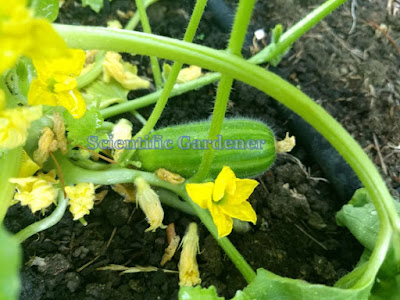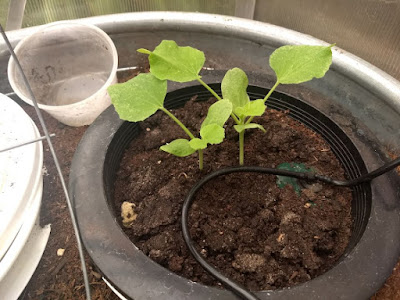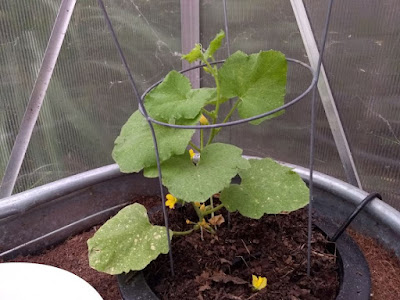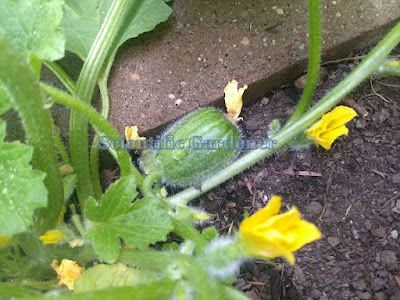For years I have grown Cucumis melo (muskmelon) fruits that are grown immature as cucumbers. Some of the highest quality of these are a type of C. melo variety Adzhur that are grown in Southern Italy. These are shorter type of cucumber called “carosello” that are grown for its tender, yet crisp texture and complex rich flavor. The majority of these cucumbers were grown by individual farming families for hundreds of years.
One of these carosello varieties is called The Tondo (or round) Galatina. The fruit of this round dark variety originates in Galatina, Italy that was recently saved from extinction by biopatriarchs Vito Mele and Francesco Bramato. The photosensitive fruit of these plants exhibit bitter-free flesh with good texture, a very mildly rich pleasant flavor and a curious fruity aroma.
What does photosensitive mean in relation to fruit? It means that the more the fruit is exposed to direct sunlight the darker the fruit becomes. Soon after the female fruit sets (is successfully pollinated) the fruits that are in direct sunlight display much darker color than those that are shaded by leaves. While all the fruit do eventually darken up many of those that become the darkest are those that were exposed to direct sunlight.Initially I had the idea that I would grow another variety of carosello cucumber first in the season. The variety was called Cucummaro di San Donato. I felt that I should grow the Tondo Galatina and, in hindsight, I am very glad that I did. The main reason why I am glad that I did has to do with when I began harvesting the fruit. Either this variety is very difficult to pollinate or is parthenocarpic. Either way, the total harvest of 10-20 fruit resulted in only a meager amount of seed. Growing the Tondo Galatina earlier in the season gave me the time I needed to try something new.
Sometimes gardeners do strange things to get desired results. Even things that would otherwise be unacceptable in other context, such as damaging a living thing, can occasionally be beneficial in the garden. Previously, I was told of gardeners who whipped their plant large tomato plant near the end of the season when it was not producing fruit. Whipping the plant with a thin apparently produced sufficient stress to induce budding and fruit set.
Just in case my whipping trial was successful, I decided to take a video of it. A couple weeks after being whipped, the majority of the fruit began producing much more seed. Whether this directly had to do with being whipped or not, I cannot say for certain. Obviously, the seed is pollinated extremely early on in its development, so not all of the seed set can be attributed to whipping. More likely, this variety requires a long season and requires very good pollination for fruit set. The first fruit may almost always be sterile and free of seeds. As this is the very first time I have grown this round dark cucumber, I cannot say for certain.
Of all the varieties I have ever grown, this one was one of the most interesting. Not specifically in the flavor - which was more like the bland light Leccese than the rich striped Leccese – but more in the smell. The smell was something fruity that I could not quite describe. The best I can describe it is somewhat like mango, but I couldn’t put my finger on it. The shape of the fruit is round, but also has ribs or ridges that go from the top to the bottom of the fruit. While historical evidence has demonstrated its presence in a book published in 1845, the fruit itself has been around for much longer.Fruit of this variety is fairly simple to harvest. By the time the fruit is mature and beginning to decay, it can be cut open and the seeds harvested without additional processing. Any gel remaining on the harvested seeds is easily removed by kneading or beating the seeds and pulp prior to rinsing them out in a colander.
For those who would like to grow the Carosello Galatina, I would say that it is not for beginners. Sure, it takes much less work than most tomato plants, but in order to produce seed, it requires much more time and attention than the majority of other Armenian or carosello cucumber varieties














































































